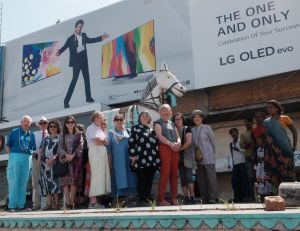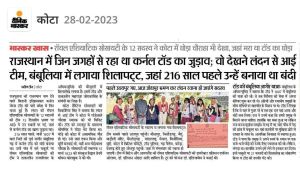Bajraj: Colonel James Tod's Horse
There are no known Hindi records about Bajraj, Tod's favourite horse. He writes about him in his Personal Narrative section of Annals and Antiquities of Rajputana published in 1828 and we learn that Bajraj had been gifted to him by his friend Rana Bhim Singh of Udaipur. There are no verified paintings of Bajraj and Tod was usually shown on an elephant.
We know that Tod was riding past Bambulia on a horse in 1807 when he was waylaid and taken to meet the Bambulia chief and they had 'two hours of pleasant conversation'. He was also offered a new horse as his was said to be lame but he refused. This event was later captured in a miniature painting commissioned by Maharaj Abhimanyu Singh of Bambulia. In 2022, in anticipation of the Royal Asiatic Society visit he commissioned the stone engraving shown in this newspaper article.
The Royal Asiatic Society tour contingent was graciously hosted for lunch in Bambulia fort by M. Abhimanyu and his daughters to mark the original occasion. M. Abhimanyu is third from the left in the newspaper article.
When Bajraj died sometime after the Battle of Mangrol in October 1821, his death 'was deemed a public misfortune'. He was buried to the south of the city of Kotah which is presumably where Tod was camped at the time. Tod describes cutting a few locks off the mane 'in rememberance of the noblest beast I had ever crossed'. In a few days he 'observed many huge stones near the spot', which before he left Kotah in February 1822 had grown into a 'noble chabutra or altar of hewn stone about twenty feet square and a few feet high on which was placed the effigy of Bajraj large as life sculpted out of one block of freestone. The old blind regent evinced his sense of the worth of Bajraj by a tomb such as his master cannot expect'. The old blind regent was 82-year old Zalim Singh Jhala who had been ruling Kotah for the previous fifty years since being appointed Regent to the 10-year old Umed Singh in 1770. Zalim Singh gave Tod a second horse, Javadia, which he rode during his subsequent travels in Gujarat.
The grave of Bajraj remained isolated outside the town until the 1970's when the area began to be developed. There was a mosque and a temple and a Muslim baba sought protection from Bajraj and lived on the plinth. The area became known as Ghore Wallah Baba's circle and still is so today. Shops have been built behind, there is a busy barber's salon and recently a shrine to Tejaji has been built next to it. INTACH put up a metal notice in the 1990's but it has long since disappeared and there is no known photo or record of the wording. The whole monument has been touched up and painted and the Tejaji pundit garlands the statue. The homeless live around his legs and he has been incorporated into the daily life. When pressed those around say the horse is Angrezi or English and so the Royal Asiatic Society from London visited the statue to make a statement.
I hope that Norbert Peabody, an accepted Kotah historian, will compose an inscription that the UIT can carve in stone for future generations.



